Arizona
New York Yankees Viewed as Suitor for Arizona Diamondbacks’ Slugger

Entering the season, the expectation was for the New York Yankees to have one of the best offenses in baseball. While their 23-13 start has been impressive, most of that hasn’t been due to their offense.
The Yankees have struggled at times to put together runs in multiple scenarios, a concerning sign nearly 40 games into the season. With the trade deadline approaching, not only will they need to add pitching, as every contending team does, but they’ll need to also address some of their offensive issues.
Looking ahead to potential options, Ryan Garcia of Empire Sports Media listed three early trade candidates ahead of the deadline. His list included Christian Walker, a right-handed slugger on the Arizona Diamondbacks.
Walker has played first base for his entire career, appearing in left field one time during 2018.
Despite Anthony Rizzo playing better in recent weeks, getting two hits including a home run in the team’s most recent win, Walker would provide them with a monster bat. Plugging him into the middle of the order could help this offense find its stride.
33-year-old Walker is a two-time Gold Glove winner at first base, too, winning those awards in 2022 and 2023.
Last season was arguably the best of his career, slashing .258/.333/.497 with 33 home runs and 103 RBIs. His 123 OPS+ was the second-best of his career since becoming a full-time player.
In the early stages of 2024, the Pennsylvania native is slashing .280/.391/.490 with an OPS+ of 151.
He’s currently playing on a one-year, $10.9 million contract, so this would likely be a rental for New York who could provide major benefits for them as they look to go all in to win a World Series this season without having to give up a big haul for an impact bat.

Arizona
The CHIPS Act transforms an Arizona neighborhood

About 7 miles south of a massive construction site where Taiwan Semiconductor Manufacturing Co., the world’s biggest chipmaker, is building three factories, one neighborhood is undergoing dramatic change.
The Golden Triangle — as at least one real estate developer calls it — occupies about a half-mile square in Phoenix, Arizona. It has about 100 houses, connected by mostly dirt roads. In addition to the human residents, many of whom moved there in search of a rural lifestyle, it’s home to horses, goats, cows, donkeys, chickens, bees and a 16-year-old tortoise named Crush.
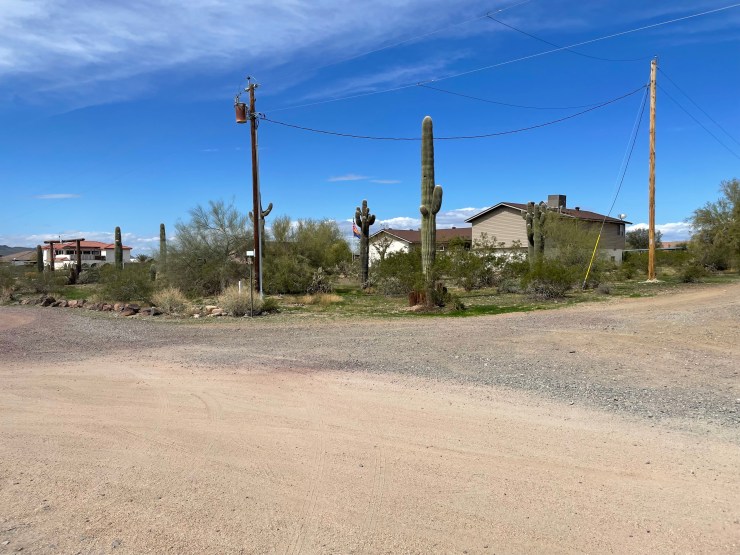
But the economy of the Golden Triangle is getting an overhaul. Three new apartment complexes, with a combined 852 units, have been approved for construction inside its borders. Developers and city officials say the housing is needed, in part, to meet demand driven by the semiconductor industry.
As part of our ongoing series “Breaking Ground,” about how federal government investment is changing the economy in complicated, invisible and contradictory ways, Marketplace looked at the impact of the CHIPS and Science Act on Phoenix. The landmark legislation is part of the government’s plan to rebuild the semiconductor industry in the United States
Residents, business owners and city officials each have their own interests in this development cycle. To explore how the changes are fanning the flames of competition among them, “Marketplace” host Kai Ryssdal spoke with these stakeholders in the Golden Triangle.
Click the audio player above to hear the story.
The small-business owners

Toward one corner of the Golden Triangle, there is a freshly built strip mall with a Mexican restaurant, a nail salon, a day care center and a couple of other small businesses. Its construction was part of a wave of commercial development in the area.
Kat Blaz, the owner of a Bricks & Minifigs franchise, which sells new and used Lego products, opened her store about 2½ years ago. “I was so excited when I found out what was going in behind us,” she said, referring to the planned apartment complexes. “It’s hard nowadays for brick-and-mortar [businesses] to survive with all the online shopping, and so the fact that we can get more foot traffic is awesome,” she said.

One door down, Yvette Stumpf, the owner of a salon franchise specializing in haircuts for kids, hopes the neighborhood’s new residents will bring more traffic to her business as well. But she has mixed feelings about how development is changing the neighborhood. “I see that as a boon to my business because it’s more people,” she said. “However, I also do not like the big-city feel, and we still feel like country.”
Those competing feelings — hopes for the benefits of development and the desire to retain the neighborhood’s character — reflect an ongoing battle over the future of the Golden Triangle as federal investment accelerates the changes.
The real estate developer
Real estate developer Charles Eckert is in the second category of stakeholder — he built the strip mall Blaz and Stumpf’s stores are in. “We’ve taken raw desert, basically, and turned it into this,” he said, gesturing toward the busy intersection.
“There were no curbs, no gutters, no sidewalks. The road was two lanes wide. That was a dirt road right there, and there was nothing here,” he said. “I’ve been developing in this area for 20 years.”
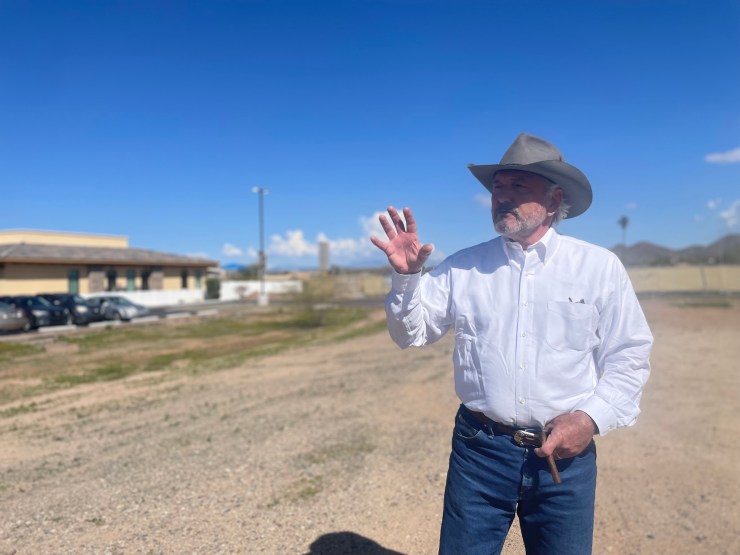
As more businesses invested in north Phoenix — some lured by state tax incentives — Eckert saw potential in that triangle. “That’s why I invested my entire net worth into this area,” he said.
Now, those bets seem to have paid off. He attracted a convenience store, an AutoZone, a Brakes Plus, a storage facility, a day care center and all the small businesses in that strip mall.
Last year, he sold some of his remaining land in the Golden Triangle to an apartment development company for $2.8 million. When making the case to the Phoenix City Council for a five-story apartment complex on that parcel, a representative for the developer cited its proximity to TSMC, the giant semiconductor producer.
“You’ve just got to look around and look at the commercial development that was coming here and say, ‘There will be housing demand here,’” Eckert said.
The neighbors
Laurel Brodie, who lives about 800 yards from Eckert’s strip mall, remembers what this neighborhood looked like before developers like him arrived.
“We’re in what used to be the middle of the desert,” she said. Brodie’s husband and father-in-law bought property here in the 1970s. They were among the first residents in the neighborhood.
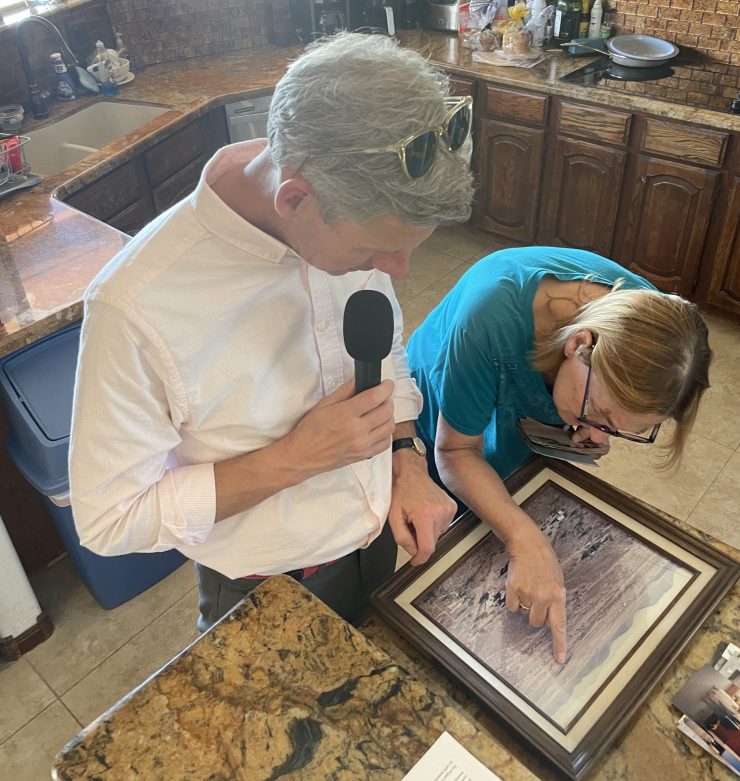
Brodie showed Ryssdal an aerial photograph of her house from 1990, when the surrounding area was almost entirely undeveloped. “There’s nothing in this,” Ryssdal observed. “You can see all the way to the mountains.”
Although Brodie acknowledges that development in the area was inevitable, she and a group of her neighbors tried, and failed, to fight Phoenix City Hall about the planned apartments inside the bounds of their unincorporated island on county land.
They argued that high-density housing — especially a five-story apartment building — is inappropriate for the area. “Even the ones on the freeway don’t go up that high, and yet they find it appropriate to put five stories right here,” Brodie said.
“It’s rather threatening to my way of life,” said Alison McKee, who lives down a dirt road from Brodie and joined her in the resistance effort.
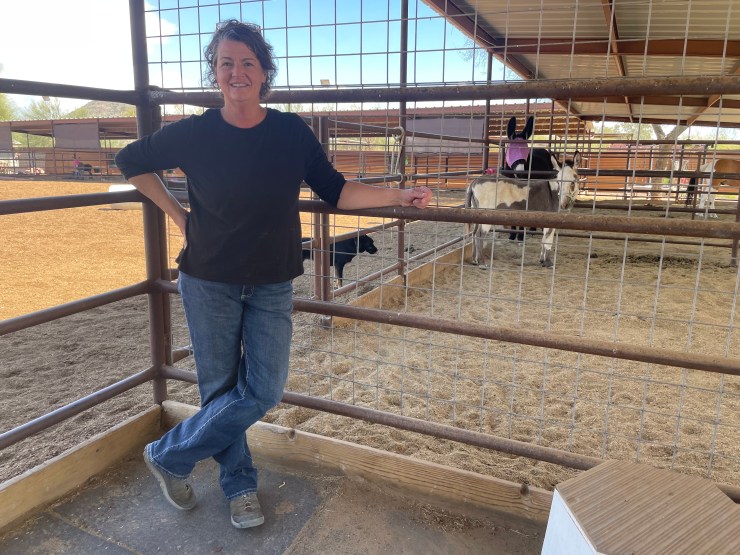
McKee and her husband bought their property about 12 years ago because they wanted land where they could have a horse. Now, in addition to the horse, the McKees have five donkeys, 26 chickens, 18 goats (nine kids and nine adults), a dog, a barn cat and a rotating cast of foster donkeys from a local rescue.
In the years since the McKees moved in, a megachurch was built across the street and shopping centers and apartments sprang up down the road. It’s clear that more will be coming with the investment in semiconductor plants.
“We do feel like we will be bowled over,” McKee said. “So am I the weird old lady that stands her ground and holds out? … Only time will tell.”
The city
Because both Alison McKee and Laurel Brodie’s properties sit on unincorporated county land, they do not pay Phoenix city taxes and cannot vote for Phoenix City Council candidates. But the city is getting closer and closer to them.
Councilwoman Ann O’Brien, who represents the district that includes TSMC and the Golden Triangle area, is responsible for balancing the competing interests. She supported the proposed apartment developments.
“You might know, we have a little bit of a housing shortage here, not just in Phoenix but the entire state of Arizona,” she told Ryssdal. “And one of my commitments when I ran for office in 2020 was to ensure that we brought a diversity of housing.”
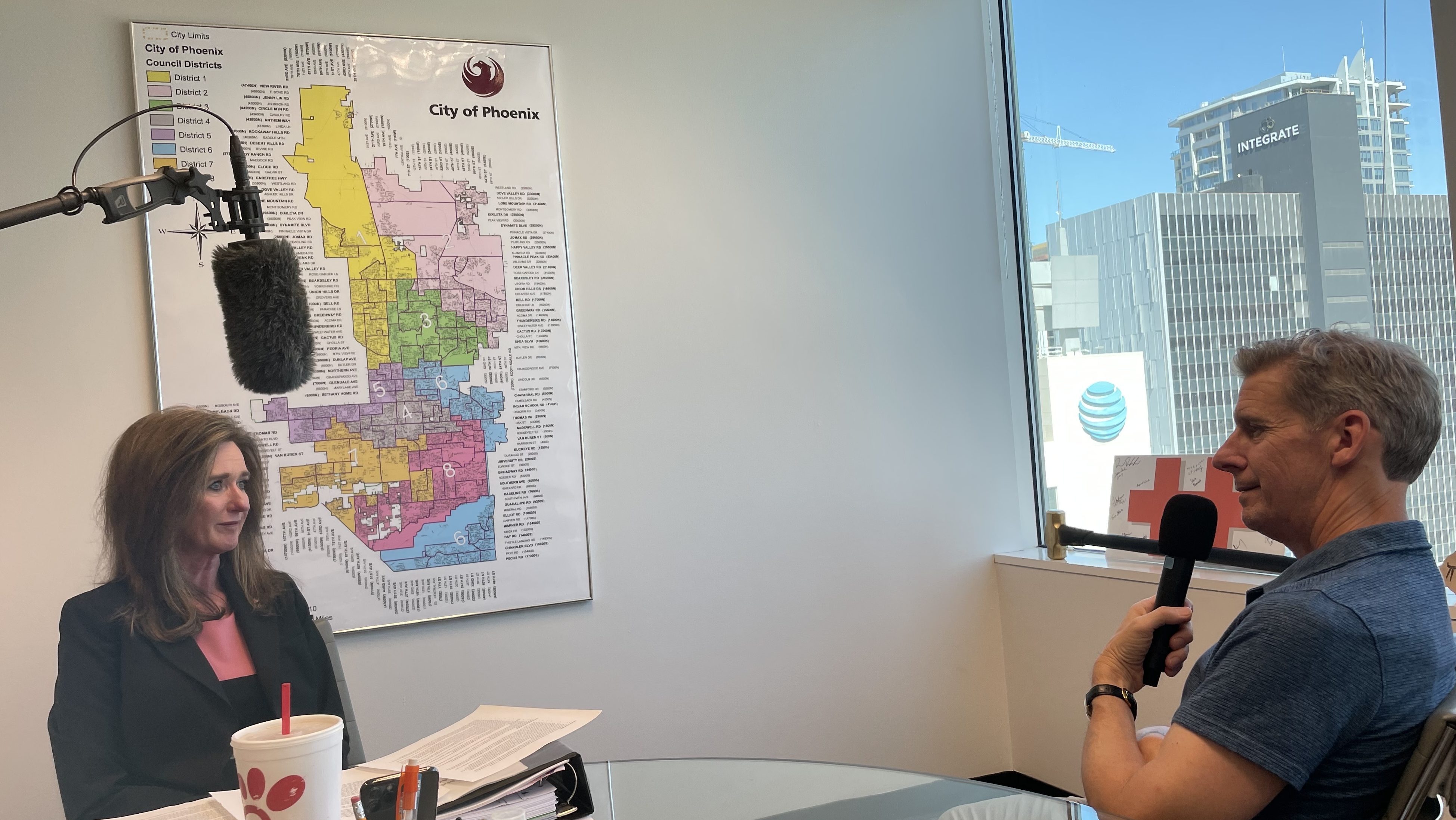
The Phoenix metropolitan area, already among the fastest-growing in the nation, received a wave of new residents during the pandemic, exacerbating a housing shortage. An Arizona State University research report found that Arizona was short about 270,000 units in 2022.
TSMC, which is investing $65 billion in Arizona with a $6.6 billion boost from the CHIPS Act, plans to hire 6,000 workers. Additionally, the company expects those factories to create tens of thousands of construction and indirect supplier jobs. Those workers will need places to live.
“Phoenix is growing, and what used to be far out there isn’t so far out there anymore,” O’Brien said.
As trillions of government dollars flow into the national economy, more communities will have to grapple with the tradeoffs of development, as the Golden Triangle has. What is happening there will happen elsewhere.
“Change is coming?” Ryssdal asked.
“It’s not just coming,” O’Brien said. “It’s here.”
There’s a lot happening in the world. Through it all, Marketplace is here for you.
You rely on Marketplace to break down the world’s events and tell you how it affects you in a fact-based, approachable way. We rely on your financial support to keep making that possible.
Your donation today powers the independent journalism that you rely on. For just $5/month, you can help sustain Marketplace so we can keep reporting on the things that matter to you.
Arizona
Arizona State puts its trust in new AD Graham Rossini in uncertain time for college sports

TEMPE, Ariz. – Per The Athletic’s research, 25 percent of power-conference athletic directors received undergraduate degrees from the institution they represent. This includes BYU’s Tom Holmoe, Indiana’s Scott Dolson and Vanderbilt’s Candice Storey Lee.
Arizona State’s Graham Rossini joined this group last week, but his association with the Sun Devils goes far beyond his college days. Rossini, 44, says he’s thought about Arizona State every day since he was 11 years old. An exaggeration, perhaps, but not far off the mark.
Growing up on the Gulf Coast in Mobile, Ala., Rossini learned about Arizona State while collecting baseball cards. An Atlanta Braves fan, he came across the card of first-round draft pick Mike Kelly. On the back of Kelly’s card, Rossini read that Kelly had starred at Arizona State, winning the Golden Spikes Award, given annually to college baseball’s top player.
A seed took root.
From 1,736 miles away, Rossini started following the Sun Devils. He watched Paul Lo Duca and Antone Williamson in the 1993 College World Series. He watched Jake Plummer and Pat Tillman in the 1997 Rose Bowl. One day a high school English teacher asked students to write letters to universities requesting info for admission. Rossini’s first letter went to Arizona State. The school sent back a poster of Sparky, its maroon-and-gold mascot. Rossini hung it on his bedroom wall.
Rossini’s father worked at Chevron. His mother first worked in software and later became a teacher. Rossini was a baseball player. He wanted to play at Arizona State but then-coach Pat Murphy didn’t offer a scholarship. Rossini flew out to the desert and tried to walk on, but at 6-foot-5, he was awkward for his position. “The tallest, skinniest catcher of all time,” recalled former Arizona State catcher Tuffy Gosewisch.
Murphy, today the manager of the Milwaukee Brewers, was honest with Rossini. “You’re good enough to make the team,” he told him, “but you may never play.” He asked if Rossini might want to work as a student assistant instead.
This is where former Arizona State players say Rossini differs from other ADs. “It’s a special kind of story for me because he’s literally washed laundry for that program,” said Dennis Wyrick, who played for Arizona State from 2000 to 2003. Asked about this last week, Rossini recalled a trip to USC, driving around Compton looking for a place to wash uniforms. “And it was like, ‘Hey, whatever it takes,’” he said.
Murphy eventually made Rossini the program’s director of operations, or as Gosewisch put it, “he was like a front office by himself.” Today, friends and former co-workers describe Rossini as approachable, humble, trustworthy, passionate, genuine, thoughtful and intentional but the word that gets repeated is “detailed.”
“He literally had his hands on everything from recruiting to scheduling, to what the uniforms look like, to anything,” Murphy said before the Brewers left for a recent trip to Houston to play the Astros. “Anyone who was part of the program at this time, call one of those players. They all knew Graham had it under control.”
Indeed, when Rossini left Arizona State to take a position with the Arizona Diamondbacks in 2008, Brendan Cunningham, a former student manager and ops director, said it felt like the head coach had left. The void was that big. Everyone was like, “What are we going to do without Graham?” he said.
Per The Athletic’s research, 40 percent of power-conference athletic directors were first-time ADs when they were hired. This includes Syracuse’s John Wildhack, who spent the bulk of his career at ESPN, and Colorado’s Rick George, who worked in Major League Baseball and with the PGA Tour.
Rossini joined this group of first-timers last week, and it sparked local criticism, even though for the last three years he had held senior positions and participated in major Arizona State projects, such as securing naming rights for Mountain America Stadium.
This is an interesting time for Arizona State. With the Sun Devils slow to embrace NIL and the football program handcuffed because of an NCAA investigation, many fans turned on previous AD Ray Anderson, who resigned under pressure in November. Despite Rossini’s background and experience, fans favored an outside candidate, one who had worked as an AD, to lead the university’s transition into the Big 12, where it will compete this fall.
During Rossini’s introductory news conference, school president Michael Crow said the school considered everyone imaginable for the position but throughout a six-month process promoting Rossini emerged as the best choice. Asked how many others he had formally interviewed, Crow replied: “Zero.”
Friends and colleagues of Rossini did not understand the initial negative reaction. One said anyone who disagreed with the AD choice simply did not know Rossini. Another called it a byproduct of Rossini himself, an executive who’s always worked in the shadows, more concerned about performance than publicity. (Indeed, a Google search of Rossini does not produce much beyond his work bios.)
New Beginnings 🔱#ForksUp /// #TogetherWeWin pic.twitter.com/oJahwWXYgq
— Arizona State Sun Devils (@TheSunDevils) May 24, 2024
Diamondbacks president and CEO Derrick Hall, an Arizona State product himself, got to know Rossini during Rossini’s time with Arizona State baseball. When the Sun Devils traveled to Los Angeles, Rossini and Hall, then with the Dodgers, always hooked up and Rossini would bring the team to Dodger Stadium. Once Hall moved to the Diamondbacks in 2005, he created a position for Rossini that dealt with customer experience.
Hall said it didn’t take long for Rossini to show he was capable of more. One big assignment led to another. Over 13 years, Rossini became Hall’s “go-to guy,” a vice president who handled some of the organization’s biggest projects. Rossini played major roles in bringing the 2011 All-Star Game and 2013 World Baseball Classic to Phoenix. He also became Hall’s project manager in the construction of Salt River Fields, the organization’s spring-training complex.
“He … does … not … miss … a .. detail,” Hall said, emphasizing each word.
In 2020, when the pandemic placed the world on hold, Rossini talked with Jim Phillips, commissioner of the Atlantic Coast Conference. The two had met when Rossini was a student manager with the baseball team and Phillips was finishing up his master’s degree at Arizona State. They had since stayed in touch, Phillips serving as a mentor. During their conversation, Rossini asked Phillips about the state of college athletics.
Phillips told Rossini not to dismiss it. There was something special about working with college athletes, he told Rossini. And the environment was perfect for raising a family. If your children are into sports, they have access to it. If they’re into arts and culture, they have access. Whatever it is, it’s there, Phillips said.
The talk stuck with Rossini, who returned to Arizona State as a senior administrator.
“It’s amazing how things kind of work themselves out,” Phillips said this week, noting how Rossini always struck him as an “old soul,” someone who listened and tried to learn. “Graham found himself exactly where he should be.”
Per The Athletic’s research, 43 percent of power-conference schools have changed athletic directors over the last three years. Some of this stems from ADs leaving for better opportunities, but it also reflects the need for institutions to find leaders who can navigate a changing landscape.
In addition to NIL and the transfer portal, the NCAA recently agreed to allow schools for the first time to pay athletes directly through revenue sharing. Although the deal is not final, it could be in place as soon as next year. The old collegiate model is dead. The next is still taking shape.
Crow said Arizona State worked six months to create a financial structure in athletics that can “weather any hurricane going forward, any tumult that we might encounter.” This, the president said, will allow Rossini and his staff to focus on ticket sales, NIL fund-raising, corporate sponsorships and winning.
Arizona State for years has been known as a “sleeping giant,” a label folks here have heard so much it makes their eyes roll. The alignment between administration and athletics has often been off, leaving fans wanting more, particularly from the school’s anchor programs. As athletic director, Rossini’s biggest task will be to mend relationships and convince fans and donors that Arizona State will not be left behind.
When Rossini left the Diamondbacks, Hall told him he hoped one day Rossini would become Arizona State’s athletic director. Rossini downplayed the idea, telling Hall that he simply intended to focus on his responsibilities. On a recent drive to Scottsdale for the Pac-12 baseball tournament, Rossini said becoming Arizona State’s AD may have been in the back of his mind, but it was never a driving force. It was more about purpose, less about title.
Friends, however, insist they saw this coming. Harvey Jabara, a longtime Arizona State supporter who owns a minority stake in the San Diego Padres, said he would have loved for Rossini to come to San Diego, but in the back of his mind he always knew Rossini’s heart was with the Sun Devils.
“This is the dream job for him,” Jabara said. “I think that’s unique in this day and age where so many people approach — not just in athletics, but in all parts of society — it’s always the next job that they’re pursuing. That’s not happening here as I know Graham Rossini.”
Said Murphy, strongly: “He will never leave ASU for another college job — that’s a guarantee.”
Throughout his career, Rossini has joked that he is a “professional problem solver,” someone who has done his best work when stakes are highest. That’s the environment he steps into at Arizona State, whose reality has seldom matched external hopes. He welcomes this challenge.
“There’s change around all of us,” Rossini said. “We’re prepared to be relevant in the areas that we need to today but also agile enough to react to the changes that happen around us. It’s a cliche — I don’t like using it — but I don’t see it as changes or challenges, just new opportunities.”
GO DEEPER
College football confidential: How NIL is used to keep players out of the transfer portal
(Photo of Graham Rossini at his introductory press conference as Arizona State’s athletic director: Michelle Gardner / The Republic / USA Today Network)
Arizona
Simmons Fire burns 300 acres near Kearny, prompts evacuations

Bear Fire burns in Benson, Ariz., in Dragoon Mountain Ranch Estates
The Bear Fire burning east of Benson, Ariz., within Dragoon Mountain Ranch Estates on May 28, 2024, was estimated at 50-75 acres.
The Simmons fire that started on Tuesday burned at least 300 acres north of Kearny and prompted immediate evacuations.
At around 6:20 p.m., the fire was reported about 10 miles north of Kearny on the eastside of the Gila River, according to the Arizona Department of Forestry and Fire Management.
By around 8 p.m., the state forester said the fire was progressing southeast due to high winds.
Pinal County Sheriff’s Office evacuated residents in the Riverside neighborhood outside of Kearny, designating the Ray Elementary School as an emergency meeting place for displaced residents.
The Arizona Department of Transportation closed State Route 177 that runs through Kearny with no estimated time to reopen.
-

 Movie Reviews1 week ago
Movie Reviews1 week ago‘The Substance’ Review: An Excellent Demi Moore Helps Sustain Coralie Fargeat’s Stylish but Redundant Body Horror
-

 Culture1 week ago
Culture1 week agoFrom Dairy Daddies to Trash Pandas: How branding creates fans for lower-league baseball teams
-

 News1 week ago
News1 week agoRed Lobster files for bankruptcy after missteps including all-you-can-eat shrimp
-

 World1 week ago
World1 week agoPanic in Bishkek: Why were Pakistani students attacked in Kyrgyzstan?
-

 News1 week ago
News1 week agoThe states where abortion is on the ballot in November : Consider This from NPR
-

 Politics1 week ago
Politics1 week agoMichael Cohen swore he had nothing derogatory on Trump, his ex-lawyer says – another lie – as testimony ends
-

 News1 week ago
News1 week agoCity of Kyle falls short of ‘Kyle’ world record
-

 Politics1 week ago
Politics1 week agoAnti-Israel agitators interrupt Blinken Senate testimony, hauled out by Capitol police




















